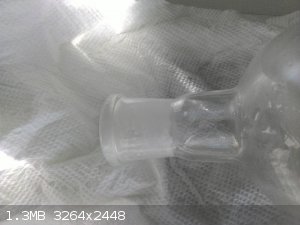ganger631
Hazard to Self
 
Posts: 53
Registered: 15-8-2014
Member Is Offline
Mood: Plata o plomo
|
|
Flask joint roughness.
After a successful attempt at distilling sulfuric acid, only to find out that my flask joint had resemble somewhat rough and nonuniform coating around
the frosted joint. The same thing had also occurred on my adapter joint. At first, i tried scrubbing it, however it doesn't seem like it wants to
budge. I had applied joint grease prior to the distillation.I also tried washing it with acid,however nothing was removed. Anyone else experienced the
same thing? Im sorry if this is a repeated topic. Thanks!

|
|
|
chemrox
International Hazard
    
Posts: 2961
Registered: 18-1-2007
Location: UTM
Member Is Offline
Mood: LaGrangian
|
|
What grease did you use? H2SO4 is sometimes used to remove grease. Silicone grease can be partially dissolved in acid and spread around the glassware.
For distilling H2SO4 I would have used PTFE sleeves or nothing. It's easier to soak a clean joint than a dirty one.
"When you let the dumbasses vote you end up with populism followed by autocracy and getting back is a bitch." Plato (sort of)
|
|
|
ganger631
Hazard to Self
 
Posts: 53
Registered: 15-8-2014
Member Is Offline
Mood: Plata o plomo
|
|
I used dow corning high vaccum grease. uhmmm i think i remember some distillate steaming out. Also wont teflon melt at that temperature range?
|
|
|
Dr.Bob
International Hazard
    
Posts: 2736
Registered: 26-1-2011
Location: USA - NC
Member Is Offline
Mood: No Mood
|
|
It may just be the sign of a cheap flask, or some minerals left from previous work. If cleaning does not help the joint, it may just be made rough
or poorly ground.
If those two items are always used together, you could put some rouge/very fine alumina/SiC powder between them, with some water and use the two
pieces to grind each other to a perfect fit. That is the way that matched glass syringes are made, but once, done, they will only fit well to each
other, not necessarily to any other items.
|
|
|
Funkerman23
Hazard to Others
  
Posts: 416
Registered: 4-1-2012
Location: Dixie
Member Is Offline
Mood: No Mood
|
|
If its a Chinese made flask then that is typical.Not saying that the usual Chinese brands( laboy, synthware, deschem, nanshin sales...) are bad at all
,but it is a common problem for their joints to be a touch rougher( don't be too stingy with the grease) or a touch off center or the tapers be a hair
off. Its almost always within comfortable tolerances but its there.IF it is US made glass then this too is possible but not as commonly seen. THe
others above are also correct: with sulfuric acid either PTFE sleeves or none at all, though in the past some clean sulfuric acid was used as joint
lube. I can't recommend you lube your joints with sulfuric acid as I am not sure if that works well anymore( or it if ever did).
" the Modern Chemist is inundated with literature"-Unknown
|
|
|
ProChem
Harmless

Posts: 41
Registered: 9-6-2008
Location: Union Beach, NJ. USA
Member Is Offline
Mood: Cynical
|
|
i used to put glassware in the oven to bake out odors and found that any residual "dow corning grease" evaporates leaving a coating of silica that
bonds to the glass. doesn't matter where the glass is made. You can regrind the joint using lapping paste of varying grit.
[Edited on 8-1-2016 by ProChem]
|
|
|